
15 minute read
Formula Student
IMechE Formula Student
Electric evolution
OBR’s 4WD, four-motor Formula Student car preparing for competition at the 2022 UK competition at Silverstone
Oxford Brookes took a bold step into electri cation with its 2022 FS challenger. Racecar speaks to team leader, Ole Ramming, about some of the hurdles the team had to overcome in the car’s development
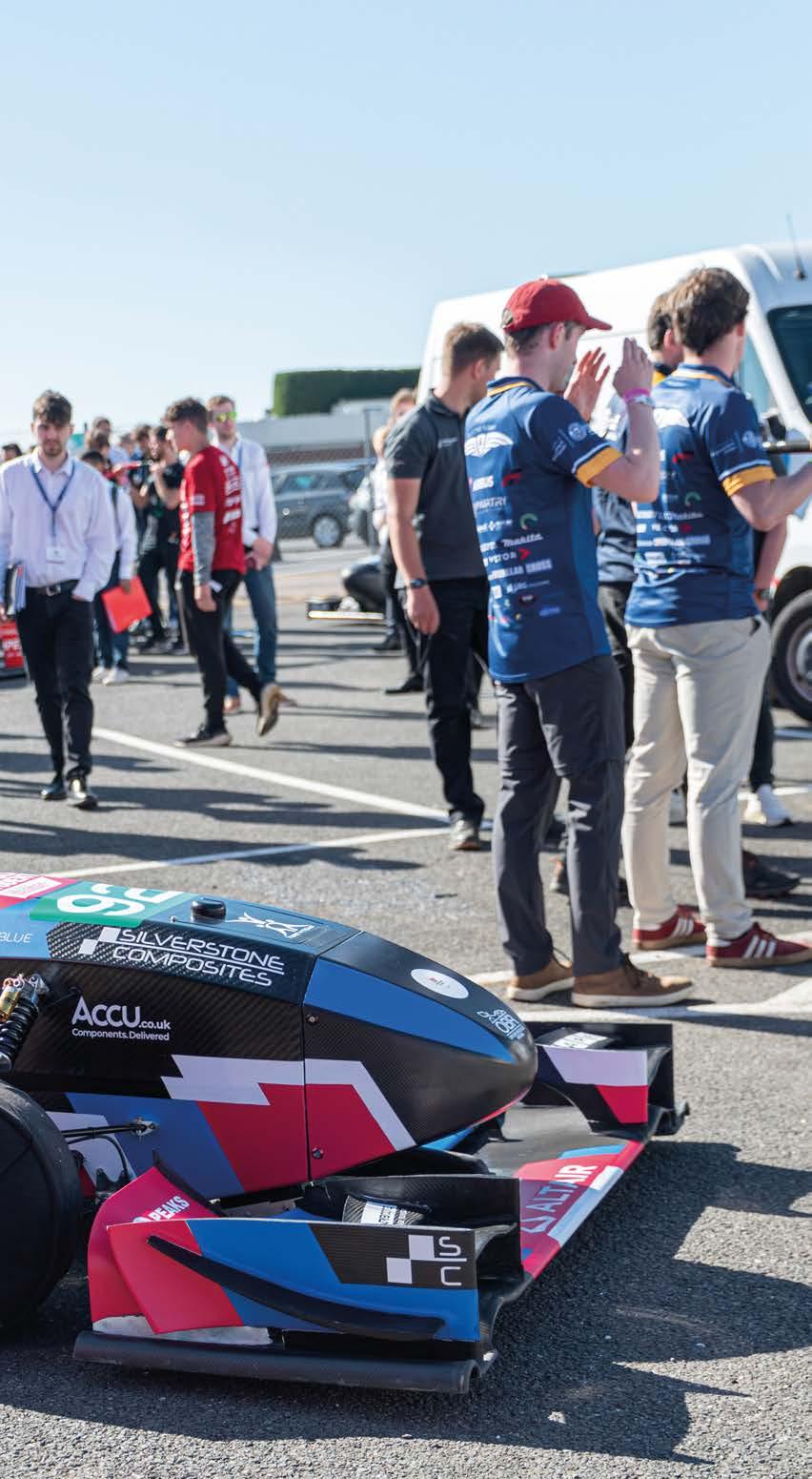
By STEWART MITCHELL
During stable regulations in most open competitions, design, operation and strategy converge as understanding increases. However, IMechE’s Formula Student (FS) is a contest that defies this logic. The technical rules accept various technologies, but the competition itself has been very similar for a long time. Over the years, teams have won the numerous parts of the competition, running diverse technological approaches to realise the FS car. The 2022 Formula Student competition at Silverstone, UK, which took place on 9-10 July, was no different.
Following the Covid pandemic, Formula Student UK was back to full strength this year. The 2022 competition sported some new elements, notably the mandatory inclusion of the expanded Lap Time Simulation event, which will encourage teams to develop vehicle dynamics in a virtual environment.
Powertrain overview
Oxford Brookes Racing (OBR) picked up no fewer than seven awards for the team’s FS and FS-AI squads, including the prestigious Formula Student Engineering Design and the Lap Time Simulation (Formula Student Class) awards for their electric FS race car.
OBR has an impressive history at Formula Student at Silverstone, finishing as a top team on seven occasions and holding the record for the most top three finishes of any UK team.
OBR team leader, Ole Ramming, a masters student in Motorsport Engineering, comments: ‘Bringing back some silverware is a great reward for all the work our team members have invested in the past nine months. In particular, winning the Engineering Design Award gives us a brilliant foundation to work on for the coming seasons.
‘Building an electric car is a very complex challenge compared to a combustionpowered vehicle. The combination of advanced control strategies with our fourwheel-drive system gave OBR’s design an edge, standing out from its competitors.’
The OBR squad built its 2022 car evolving on a long-standing foundation. The university has 23 years’ experience in FS, predominantly with internal combustion cars, but decided to go all electric in 2019. The first dyno testing occurred at team partner firm, GKN’s, facilities in late 2020, with the bulk of the testing taking place throughout the first half of 2021, ahead of the 2021 FS competition.
The team was set to run its first electric car in the 2021 competition, though the number of system operation challenges it faced meant it didn’t turn a wheel that year.
‘There are always hiccups in developing new racecars, and in 2021 there were enough hiccups to derail it far enough that the car didn’t run,’ explains Ramming. ‘The accumulator wasn’t in a finished state. Everything else was fine as far as the electronic system was concerned, and we passed all the electrical checks up to the point where we needed proper accumulator operation. Unfortunately, the accumulator wasn’t in a state where we could present it. But we learned from that and got the car to work developing the old platform and transitioning to a new one.’
OBR knew the 2021 car’s accumulator concept fundamentally worked, validating it and testing it on a pack level. On a system level, the powertrain itself was good. However, there were a lot of issues in terms of communications – mostly CAN bus communication systems. So the team reworked the wiring scheme, making it much more modular to service it better.
‘The previous year’s design was a bit of a nightmare, especially with troubleshooting something like communications, as we had two main harness wires going through the entire car and a bunch of strands going from those to every component,’ notes Ramming. ‘Troubleshooting that if you can’t access those connections is quite tricky. Especially if they then interface with the high voltage system. So we re-designed that part of the car from the ground up, and it’s now much more stable and reliable.’
The OBR team also made significant structural changes to the chassis to better integrate the accumulator.
‘We wanted to change the rear impact structure to integrate directly with the accumulator. It is now permanently attached to the accumulator and holds it in place rather than being separate structures,’ explains Ramming. ‘Most of the chassis was adapted to support this, including revising the laminates for the monocoque. Fundamentally, it’s the same concept but with a higher-grade material.
‘Silverstone Composites is our composites partner and advised heavily on re-designing, as well as helping us access other partners. They’ve got an autoclave that fits our chassis, which was ideal for consolidating the entire structure, leaving room for optimisation thanks to that.’
OBR tested the 2022 car for the first time at the end of Q1 2022. The most critical items the team recognised needed to be checked and calibrated ahead of the competition this year were the electronic loom, communications, safety and stability systems.

The car’s accumulator is directly integrated into the rear impact structure, sitting in a high-grade carbon fibre case behind the driver
Powertrain overview
The new chassis provides slightly different dynamics than its predecessor because it extends behind the rear axle, and the accumulator sits further back in the car. The centre of mass of the accumulator is slightly in front of the rear axle, providing the desired driving weight balance front to rear.
It consists of 288 pressurised pouch cells configured in a 144S 2P arrangement with six modules of 100V each. OBR defined this arrangement from a functionality standpoint. The pouch cell design is convenient for packaging, but can be slightly more challenging to cool. For simplicity, the cells are actively air cooled via a fan, which drives air through the pack at a constant load while the car is in operation. 600V DC bus voltage is the highest allowable in FS for electric vehicles. Additionally, the motor and inverter package are regulation limited to an 80kW peak output. As these systems work more efficiently at a higher bus voltage, the team opted to reach for the top voltage figure.
‘To operate the motors most efficiently at the 80kW maximum deployment, we want the highest pack voltage to bring the current down,’ notes Ramming. ‘Fundamentally, high voltage means low current; that’s our chosen trade-off. High current means bigger cable sizing, power electronics, higher operating temperatures and all the other electronic knock-on effects of having high currents, which were unacceptable for our design.’
Pressurising the cells provides consistent and constant performance across the pack in operation (power output in terms of efficiency) and temperature management.
‘It runs hardwire logic, so there are many relays, an external disconnect shutdown
circuit, overcurrent and grounding measurement and protection – similar systems used in electric / hybrid series across motorsport,’ explains Ramming.
‘We also designed in many failsafes to prevent single points of failure and prevent the car from going live and high voltage if a specific sequence is not triggered. That involves several steps and more than one person. Fundamentally, it is the system checking itself, then the electrical safety officer, or someone outside the car, turning the car on, then giving control to the driver, who also has to confirm that in several steps. At any point, the control system, the driver, or an external person can shut the car off, which then renders the car safe.’
Four-motor drive
The car is four-wheel drive with an AMKsupplied in-wheel motor on each corner. AMK supplies a complete package with both motors and inverters. In terms of performance, they deliver 35kW each and are easily integrated into the in-wheel location.
‘Their size means we can package all-wheel drive nicely, giving you access to regenerative braking on all wheels, torque vectoring and other dynamics you want on an EV car,’ notes Ramming. ‘We considered having the single electric motor with a conventional differential and others that run two motors with a digital differential. But we decided early in the concept in 2019 to go with the four in-wheel motors and build a control system for it ourselves.
‘It’s one thing we must consider early because it influences the accumulator pack sizing, the power electronics, the wheel packaging and the chassis packaging. It is a bold step into electrification. It is not just adding the complexity of the EV system in the first instance, but the complexity of inhub systems and all-wheel drive.
‘Several years into the development, we understand the system well enough to exploit its potential.’
An in house-designed torque distribution system independently controls each and makes up part of the vehicle control system.
Regarding cooling the inverters and motors, as a package from AMK, the team receives heat rejection figures and has to design a cooling system to suit. OBR went for water cooling, necessary for the motor type and performance density.
‘Being in the airstream around the wheel group components wouldn’t be sufficient for the cooling requirements,’ notes Ramming, ‘but there is too much in the way to get a nice air stream to feed the motors. The inverters are especially hard to cool as they are inside the car. We’ve got a dedicated inverter circuit and two cooling loops for the motors on each side of the vehicle. It required an additional pump, but it also means the temperatures themselves are a lot more consistent. Much thought, simulation and validation went into developing the cooling system to ensure we stay in the temperature ranges we want.’

The four-wheel drive car features liquid cooled in-wheel motors. Note the coolant lines from the onboard heat exchanging system
EMI mitigation
Electromagnetic interference (EMI) is a constant battle in any high voltage system with switching frequencies of this magnitude. Much of the mitigation is in the form of a physical shielding between the components that emit or are susceptible to EMI and grounding. OBR carried out a lot of testing on stands and offline to deal with this.
‘The placement of electrical powertrain elements makes a huge difference,’ highlights Ramming. ‘Things like the high voltage cables had to be well thought out in such a small car because there’s not much room to position them. Putting them close together, we found, is not a lot of fun. So that’s something we learned over the process of actually building it. We initially didn’t predict that in the design phase because we had never developed an EV FS car before. This year, we can finally benefit from having done it.’
The front two motors connect via high voltage lines from the car’s rear, where the accumulator and inverter are located. The original design saw two high voltage cables run parallel down the car’s centre, but without any shielding in between. That caused communications to drop, which then can shut down the signal to the motor, meaning the motor delivered no torque and could deploy no power.
This year, OBR fixed that by adding aluminium shielding between the cables. Copper mesh is used for the inverter boxes and graphene spray on the junction boxes.
It is a bold step into electrification. It is not just adding the complexity of the EV system… but the complexity of in-hub systems and all-wheel drive
The 5.86kWh accumulator pack was sized appropriately for the most challenging part of the competition, the 22km endurance event.
‘We understand the power demand from the motors running them at 80kW maximum and within the operating window,’ explains Ramming. ‘Then the question becomes, how much of that do we actually need to bring with us? Regenerative braking is essential for us. The pack was sized with a certain amount of regenerative braking, based on lap time simulation around the Silverstone track, which we know pretty well because it’s quite consistent between years.
The regenerative braking amount depends on the set up and power demand.
‘We’re looking to regenerate quite a high amount of energy – upwards of 20 per cent,’ highlights Ramming. ‘That makes the pack relatively small and leaves us with a lower margin for error, or degrades performance if we get the use case wrong.
‘The track lends itself to regeneration because we have a lot of braking and transitional throttle moments where we can make the most of it. We can regenerate many tiny moments between the intense braking moments, especially in an all-wheel drive torque vectoring system. We benefit from that.’
Vehicle dynamics
Managing the vehicle dynamics alongside that regenerative braking, in terms of brake feel and what happens to vehicle handling when it goes into that pinch moment as negative torque from the wheels, was a big challenge. OBR developed the vehicle dynamics and the kinematics of the car with the effects of regenerative braking in mind. The team then tune the behaviour using regular mechanical car set-up elements such as spring stiffness and damper settings, as in other forms of motorsport.
The driver can also adjust the amount of regeneration from the cockpit with electronic tools. A certain amount of deceleration must be hydraulic braking at the end of pedal travel, but the rest is through regeneration. OBR can also change this via pedal spring settings so, if the driver wants a shorter pedal travel for different spring stiffness for the initial bit of regeneration before they hit the hydraulics, that can be tuned in.
The regenerative braking is very sophisticated, though it isn’t the most challenging part of driving in this car,’ notes Ramming. ‘The most significant change from the driver’s perspective was getting to grips with electric all-wheel drive. That’s probably the most prominent sensation as it’s potential has a much higher performance ceiling and delivers torque in a very different way.
‘Once we run the car even more, we can get the visibility of nailing that down. But that’s probably years of development rather than just days of testing.’
FS cars have such extreme aero nowadays that they can produce load at as low as 20mph. Like most FS teams, in terms of design, OBR’s 2022 car’s aerodynamics is something the team started from the ground up when designing the vehicle, and it’s been iterated over several CFD runs before they generated the final solution.
‘We reviewed every iteration we made in CFD internally and with industry expert partners. We’re lucky enough to have that,’ says Ramming.
‘With the shift from IC to the electric powertrain, our cooling demand has changed. We considered that as a large part of CFD in terms of what we developed. We don’t have an exhaust now, so we’re not messing much with the car’s rear-end airflow. That is probably offset, or at least traded, with getting cooling in from the front of the car as we now need throughput to the accumulator.’
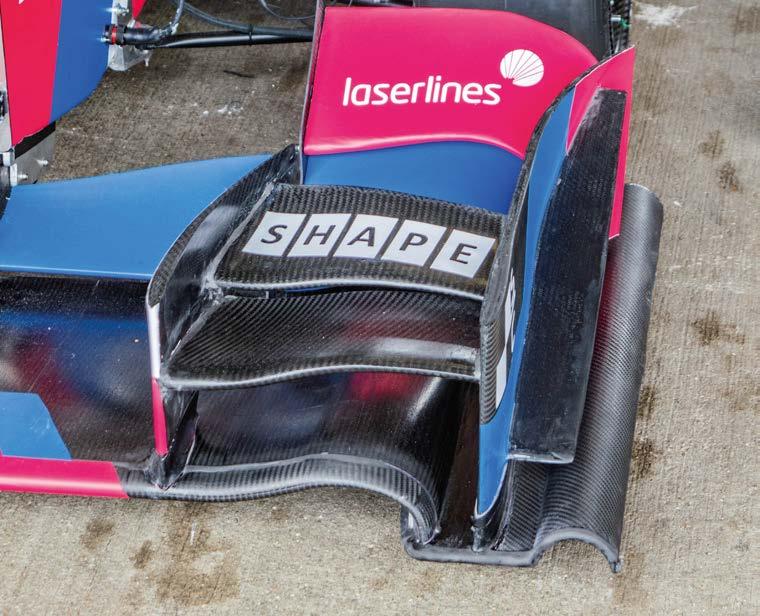
The advanced front wing design provides high front end loads as well as flow field conditioning for structures behind the front axle
The car’s aerodynamics are a refined version of the team’s 2021 design. This is one of its CFD renderings of front wing flow structure

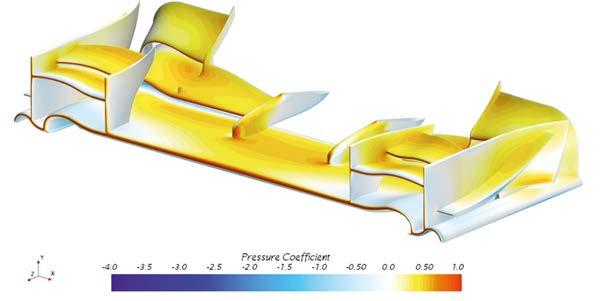
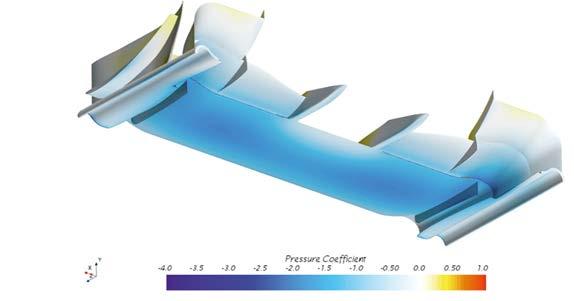
Front wing upper surface aerodynamic load profi le
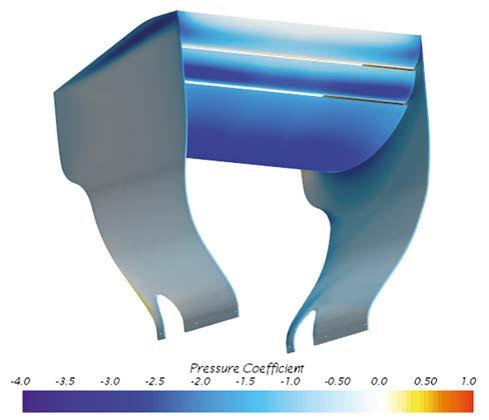
Rear wing lower surface aerodynamic load profi le Front wing lower surface aerodynamic load profi le

Rear wing upper surface aerodynamic load profi le
As for the entire aerodynamic concept, OBR ran a similar system last year, but it’s been refi ned in many details.
‘If you compare the aerodynamics from the previous year to this year, you’ll fi nd a lot of re-profi ling,’ says Ramming. ‘There’s been a lot of optimisation of profi les within the boundary boxes. Rather than changing conventions, we’re running the same tiploaded concepts on the outboard front wing, and everything after that is also optimised.
‘We’re at the point where the downstream aerodynamics are now a relevant factor, and we have to think about how we manage the fl ow around suspension and tyres. In terms of complexity, we’re at the upper end of what you’ll fi nd in a Formula Student paddock, which is something we’re proud of.’
Generally, getting to this year’s competition wasn’t easy. With the fall out of Coronavirus and chip shortages still causing chaos throughout the technology industries, the strength of the fi eld and the number of cars running this year was great to see.
25 years of innovation
Formula Student UK competition was back to full strength for 2022, which marked the 25th anniversary for the UK competition.
The Silverstone paddock was packed with teams from numerous national and international universities all vying for glory. Despite the formula remaining similar over the years, the open technical nature of Formula Student has seen teams develop vastly diff erent racecars. Recently, many universities have shifted from internal combustion (IC) cars to fully electric. The 2022 event saw more than half the teams competing use electric power, though even these were vastly diff erent in concept.
The powertrain confi gurations at this year’s competition ranged from inline four-cylinder and twin-cylinder motorcycle IC engines to single or multiple radial fl ux electric motors in rear-wheel-drive layout to four-wheel-drive arrangements, driven by four radial fl ux inwheel motors to dual motor formats operating digital diff erentials for the front and rear axles respectively. Some cars ran with advanced energy recovery technology, electronicallygoverned torque vectoring traction and stability control systems, and even hydraulically- controlled active suspension.
Interestingly, the chosen powertrain confi guration seemed to have little bearing on cars’ success in the competition. Glasgow Racing won the event overall with its IC-powered car, the fi rst team from Scotland to win the event.
Runners up in the main competition were the IC-powered University of West of England, with the IC-powered University of Malta in third place.
Oxford Brookes University’s electric machine (detailed here) prevailed in the Engineering Design category, and the University of the West of England won the Presentation event. The University of Strathclyde scored highest for the Cost event with its electric car, and University of Porto won the Concept class overall for its RWD direct single-motor electric machine.
Formula Student continues to demonstrate that, despite our deep technical understanding of motorsport engineering, innovation can still lead to success. This is precisely what the competition aims to instil in the participants.










